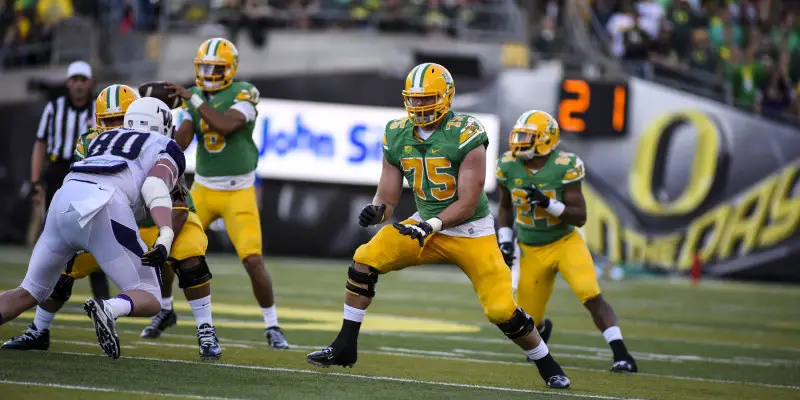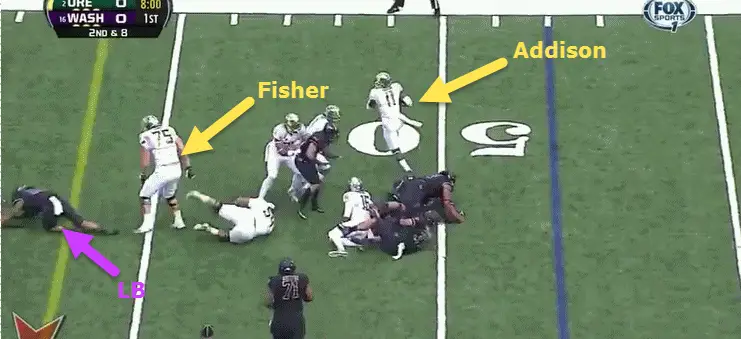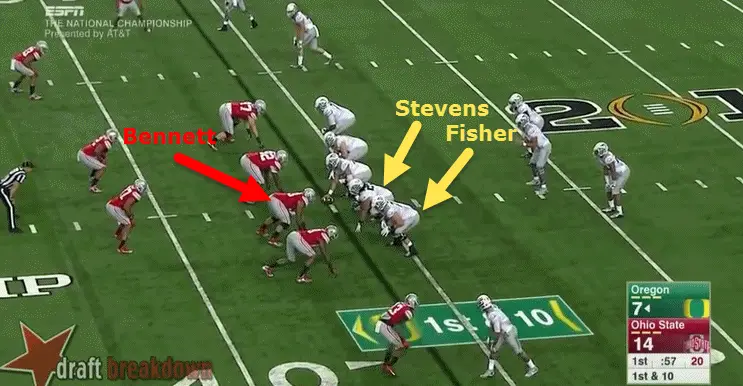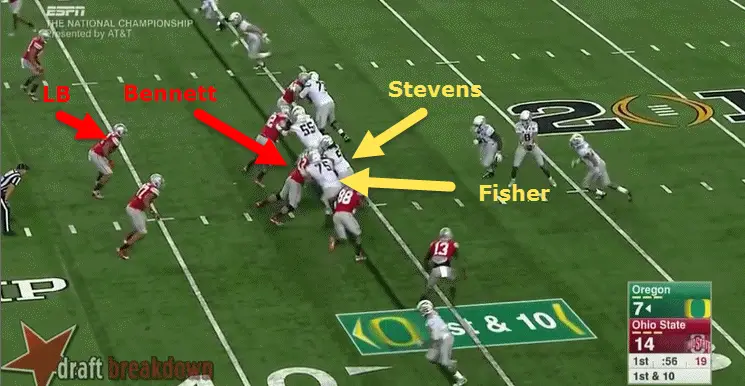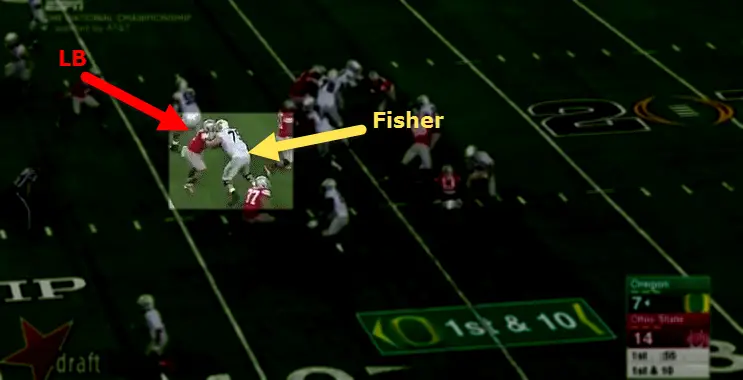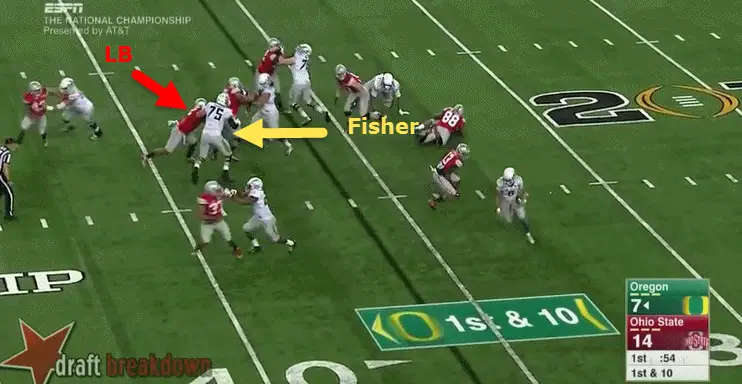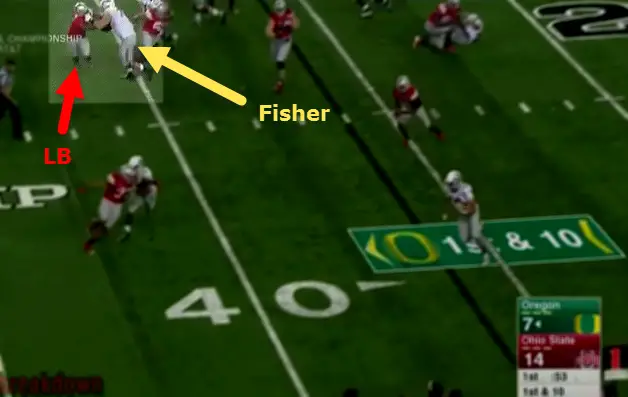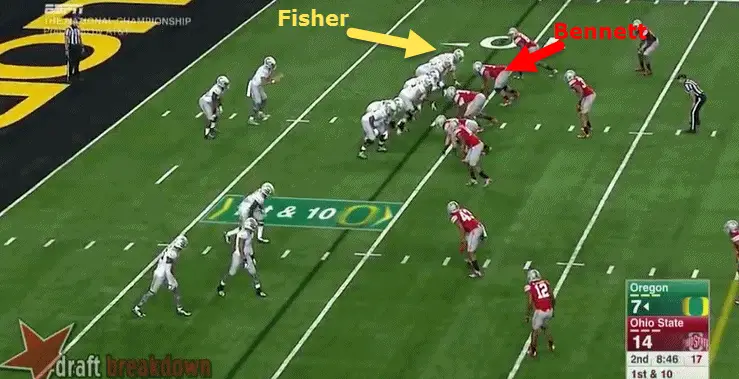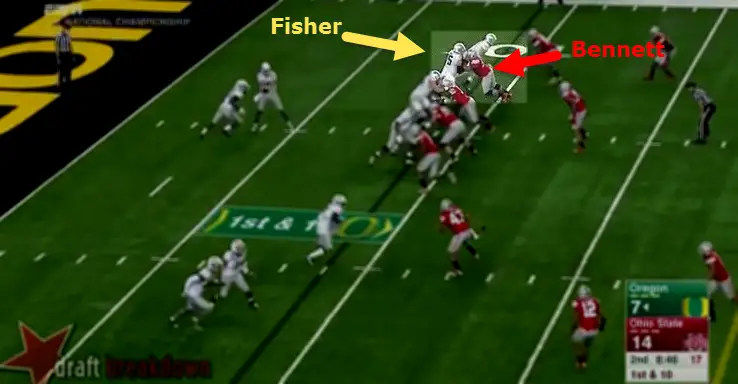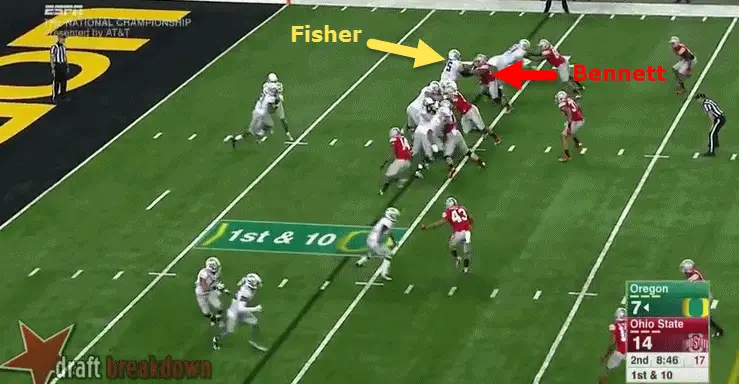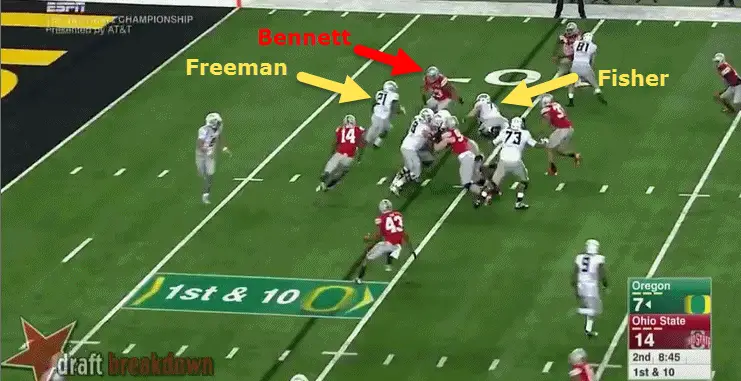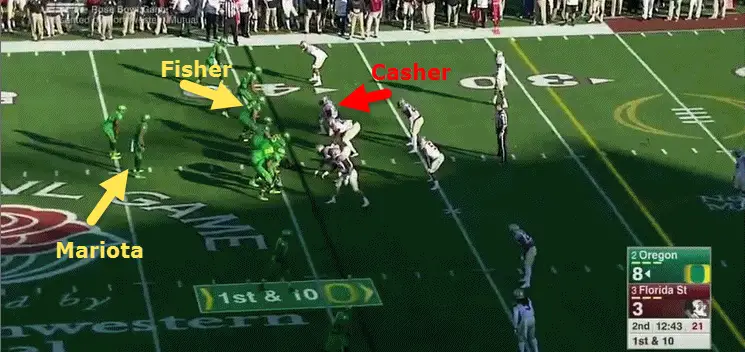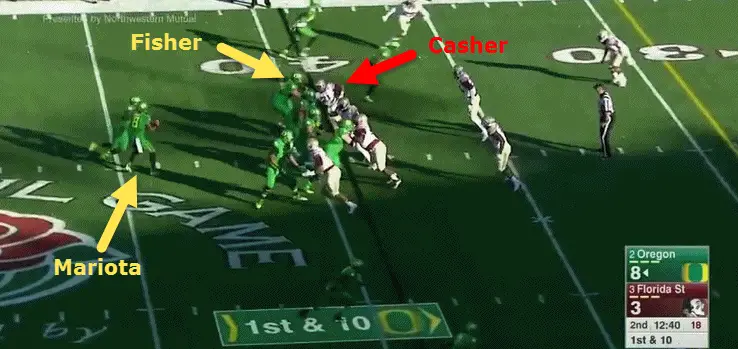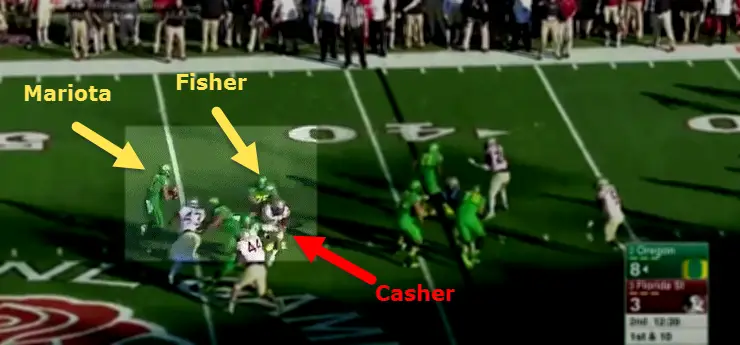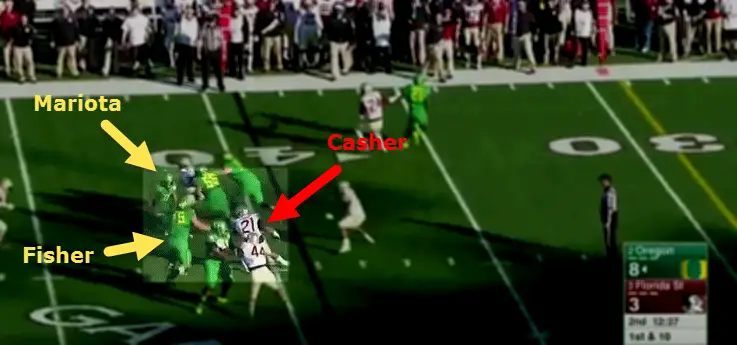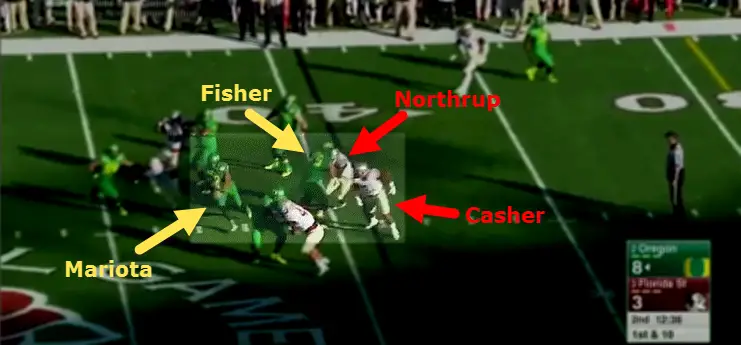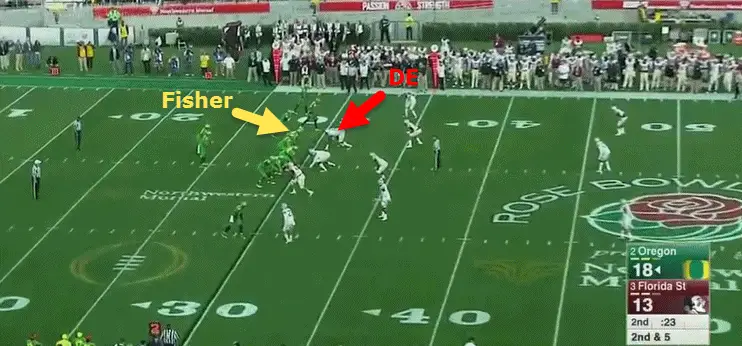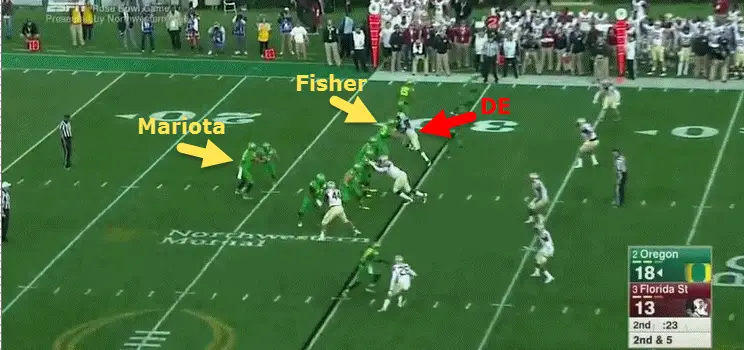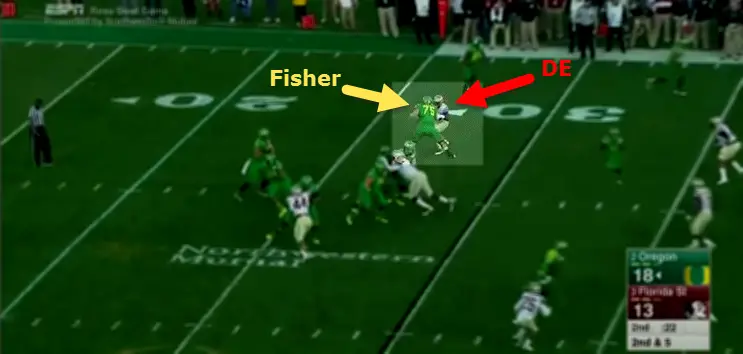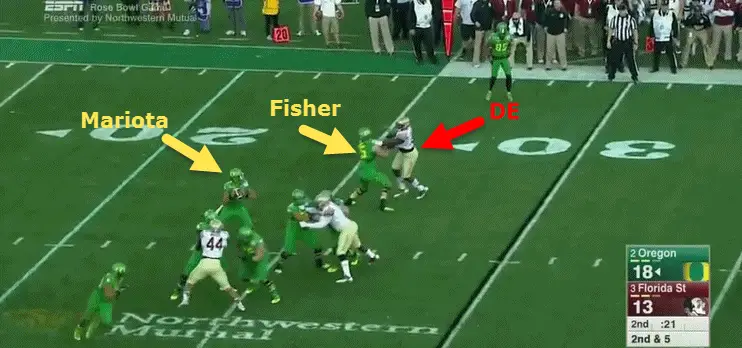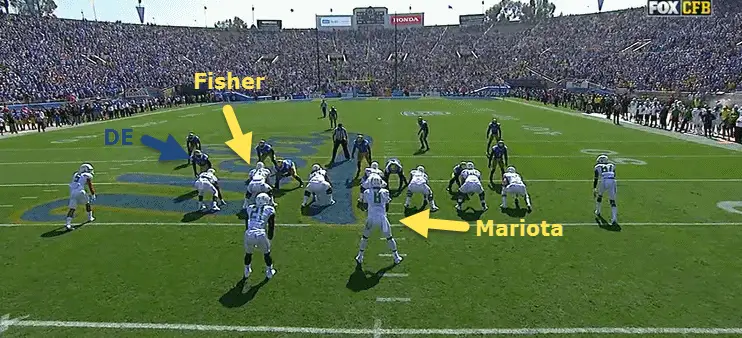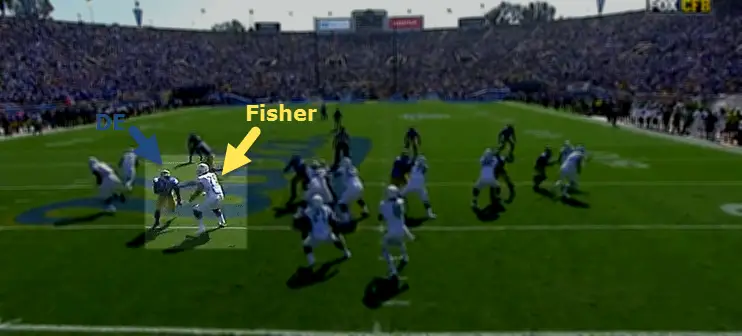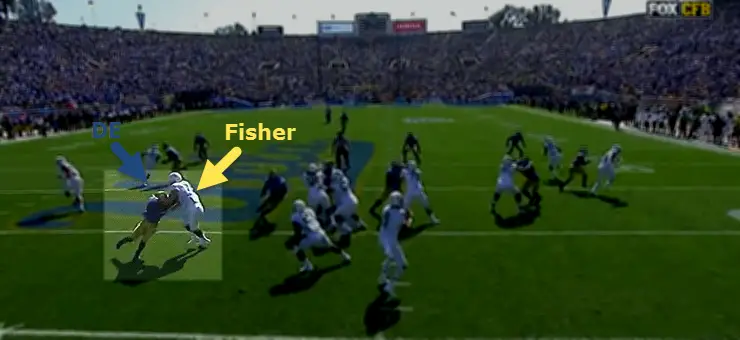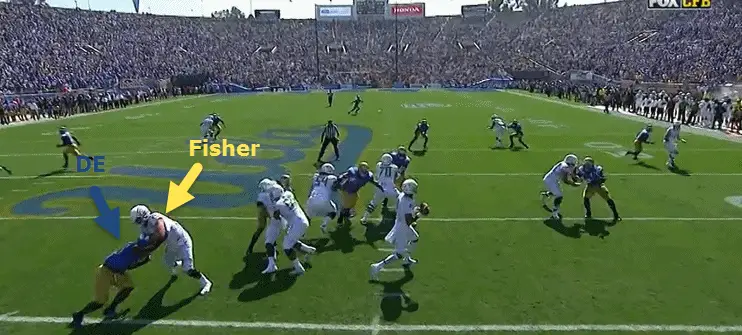Although Marcus Mariota won the Heisman Trophy in 2014, it is not a stretch to say the man protecting his blind side saved the Ducks’ playoff hopes.
Jake Fisher was not supposed to be Oregon’s left tackle last year. However, an ACL injury to the slated left tackle Tyler Johnstone forced Fisher’s move from right tackle to left, where he had started in 2012 and 2013. Fisher’s importance became all the more apparent when he missed two games due to injury. The Ducks’ offensive line struggled in a narrow victory over Washington State and a defeat to Arizona. His return seemed to stabilized the offense, as evidenced by 14 sacks given up over the final eight regular season games. In short, Fisher’s presence served as the fuse to ignite the explosive Oregon offensive line, making it clear that success on that side of the ball starts up front.
Measureables
To put it mildly, Fisher wowed scouts at the NFL Combine with his exceptional 10 yard shuttle, 40 time, 3 cone drill, and vertical jump. The former high school tight end followed that performance with an impressive showing at Oregon’s Pro Day. His athleticism makes him a great match for a zone-blocking offense.
Run Blocking
Because the Ducks predominantly use a zone-blocking scheme, athletic linemen are vital to creating space for Oregon’s seemingly endless stable of quality running backs. With his agility and quickness, Fisher fit the mold perfectly. He particularly excels at coming off of double teams and sealing off linebackers at the second level. As any developing lineman, he needs some fixing of his technique, but overall his impressive potential in a zone-based offense is obvious on tape.
Play 1: 2013 Regular Season Week 7 @ Washington
Oregon ran a fly sweep on this play (above), where Fisher (#75, right tackle) attacked a Washington linebacker.
Though the linebacker (above) read the play correctly, Fisher’s athleticism kept him out of the backfield. Fisher then got his head to the right of the linebacker and cut him off from the outside.
Once Fisher got his legs chopping (above), the linebacker didn’t stand a chance, and Fisher moved the linebacker with ease.
This play exemplifies the fact that Fisher (above) almost always finishes his block. He played like a true road grader here, planting the linebacker into the ground.
Play 2: 2015 College Football Playoff National Championship Game vs. Ohio State
The Ducks ran an inside zone read to the right on this play (above). Fisher (#75, left tackle) was uncovered, meaning that there was no defensive lineman across from him or shaded on the play-side. Meanwhile, left guard Hamani Stevens (#54) was covered by Ohio State three-technique Michael Bennett (#53). Fisher stepped to the right and he proceeded to help Stevens block Bennett.
Fisher (above) helped Stevens get a decent push on Bennett, making it easier for Fisher to peel off the double team and again block the linebacker.
Some offensive linemen struggle with getting to linebackers. However, Fisher’s athleticism ensures he gets to the right spot. More impressively, he reliably gets his hands on the linebacker, as he did on this play (above).
Though Fisher won this battle due to his strength advantage, one flaw in his run blocking game was clear on this play. He is inconsistent at maintaining a low base, which causes him to lose leverage on defenders.
Fortunately, Fisher (above) recovered from his misstep. He moved his feet quickly to use his legs against the linebacker, thus regaining control over him with both hands. Fisher’s ability to recover from an initial mistake merits praise, despite the fact that it reveals some holes in his game.
Play 3: 2015 College Football Playoff National Championship Game vs. Ohio State
The Ducks called their bread and butter play yet again, the inside zone read. Fisher (above, #75, left tackle) was covered on this play, with Bennett (#53) lined up as a five-technique shaded to the play-side.
Fisher (above) again failed to maintain proper pad level. Bennett used his lower base to gain leverage on Fisher, and he got his hands into the tackle’s chest.
This allowed Bennett (above) to create some separation from Fisher, and Fisher lost control over Bennett. Seeing an opportunity to shed the block, Bennett got his head into the running lane.
Using the push-pull technique to toss Fisher aside, Bennett (above) made the tackle on running back Royce Freeman. Fisher needs to maintain proper pad level, especially against defensive linemen.
Pass Blocking
Under Oregon offensive line coach Steve Greatwood’s tutelage, Fisher developed a variety of pass protection sets. Fisher’s natural aggressiveness makes him adept at using the jump set, a type of protection in which an offensive lineman attacks a defender at the line of scrimmage.
Fisher’s quality footwork also allows him to thrive using the vertical set, where he moves backward to respond to the defensive lineman’s chosen pass rush technique. Even though his stance is occasionally too high, Fisher is a superb pass blocker.
Play 4: 2015 Rose Bowl Game vs. Florida State
While quarterback Marcus Mariota (#8, above) challenged defenses with his mobility over the course of the season, he also required offensive linemen to adjust when he left the pocket. On this play, Fisher (#75, left tackle) showed his athleticism, halt Florida State defensive end Chris Casher (#21) on a broken play-action pass.
Fisher (above) got off to a good beginning, jump setting with his right foot and engaging Casher. The danger in jump setting is that an offensive lineman can miss his block early and fail to recover, but Fisher’s good instincts prevented just that possibility.
Casher (above) shot the gap on Fisher’s right side. Fisher responded by using his hips for control, shutting down Casher’s inside rush.
When Mariota (above) to fled the pocket, Casher made a spin move to get to the quarterback. Casher returned to the outside, where there was some open space.
Fisher (above) ran across the gap to give Mariota some time to roll out to the right. He took the unblocked defender, Florida State linebacker Reggie Northrup (#5), giving Mariota the time needed to make his throw.
Play 5: 2015 Rose Bowl Game vs. Florida State
Throughout the season, Fisher often controlled the edge against the blindside pass rusher. In this play, the defensive end (above) tried to beat Fisher around the outside.
Fisher (above) used the jump set again and hit his target.
Fisher (above) moved his hips square to the defender and controlled the edge.
As a result, Mariota (above) had all day to throw. Fisher’s knee bend neutralized the defensive end’s momentum. Checkmate, Fisher.
Play 6: 2014 Regular Season Week 7 @ UCLA
On this play (above), Fisher will move his feet back in a vertical set.
Unlike the jump set, the vertical set requires Fisher (above) to be patient and read the defensive end. Fisher stepped back with his left foot and shadowed the defensive end.
The one flaw in this play is Fisher’s overly upright position. A more polished pass rusher would have gained leverage on him and gotten separation, enabling him to keep the pass rusher at bay.
Instead, Fisher (above) gained control with his hands, using his strength to take the rusher out of the play.
Conclusion
Fisher has rare athleticism for an offensive lineman and complements it with a nasty streak. Many NFL teams heavily use zone-blocking in their run offenses and Fisher should transition smoothly if he is drafted by one of them. He has the skillset to succeed very quickly either as a guard or right tackle. Though he played left tackle last year, Fisher needs to bulk up and refine his technique before he squares off with the NFL’s elite edge rushers at the left side. Expect an NFL team to draft Fisher late in the first round.
I may be in Pennsylvania, but “Oh how we love to learn about your beloved Ducks!”
Joe Kearns
Oregon Ducks and Philadelphia Eagles Football Analyst for CFF Network/FishDuck.com
State College, Pennsylvania
Top Photo by Craig Strobeck
Joe Kearns is a senior at the Pennsylvania State University majoring in Economics. He intends to pursue a career in the banking and financial services industries, but is also a lifelong diehard Philadelphia Eagles fan who enjoys analyzing college and pro football film as a hobby. Along with being a fan, Joe’s football knowledge comes from his days as a center, defensive tackle, and long snapper for his high school in Mt. Lebanon, Pa. Though he is a Nittany Lion, he has taken a great interest in the Oregon football team since Chip Kelly became the Eagles head coach. He loves pancakes ( and not just the breakfast food).

